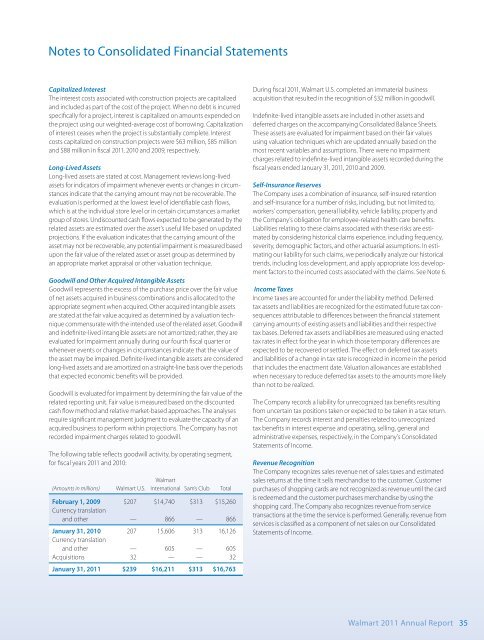Notes to Consolidated <strong>Financial</strong> Statements1 Summary <strong>of</strong> Significant Accounting PoliciesGeneral<strong>Wal</strong>-<strong>Mart</strong> Stores, Inc. (“<strong>Wal</strong>mart,” the “Company” or “we”) operates retailstores in various formats around the world, aggregated into three reportablesegments: (1) the <strong>Wal</strong>mart U.S. segment; (2) the <strong>Wal</strong>mart Internationalsegment; <strong>and</strong> (3) the Sam’s Club segment. We are committed to savingpeople money so they can live better. We earn the trust <strong>of</strong> our customersevery day by providing a broad assortment <strong>of</strong> quality merch<strong>and</strong>ise <strong>and</strong>services at every day low prices (“EDLP”) while fostering a culture thatrewards <strong>and</strong> embraces mutual respect, integrity <strong>and</strong> diversity. EDLP isour pricing philosophy under which we price items at a low price everyday so our customers trust that our prices will not change under frequentpromotional activity. Our fiscal year ends on January 31.Principles <strong>of</strong> ConsolidationThe consolidated financial statements include the accounts <strong>of</strong> <strong>Wal</strong>-<strong>Mart</strong>Stores, Inc. <strong>and</strong> its subsidiaries. All material intercompany accounts <strong>and</strong>transactions have been eliminated in consolidation. Investments inunconsolidated affiliates, which are 50% or less owned <strong>and</strong> do not meetthe consolidation criteria <strong>of</strong> Topic 810 <strong>of</strong> the <strong>Financial</strong> Accounting St<strong>and</strong>ardsCodification (“ASC”) are accounted for using the equity method.These investments are immaterial to our consolidated financial statements.The Company’s operations in Argentina, Brazil, Chile, China, Costa Rica,El Salvador, Guatemala, Honduras, India, Japan, Mexico, Nicaragua <strong>and</strong> theUnited Kingdom are consolidated using a December 31 fiscal year-end,generally due to statutory reporting requirements. There were no significantintervening events during January 2011 which materially affected theconsolidated financial statements. The Company’s operations in the UnitedStates <strong>and</strong> Canada are consolidated using a January 31 fiscal year-end.Use <strong>of</strong> EstimatesThe consolidated financial statements have been prepared in conformitywith accounting principles generally accepted in the United States. Thoseprinciples require management to make estimates <strong>and</strong> assumptions thataffect the reported amounts <strong>of</strong> assets <strong>and</strong> liabilities. Management’s estimates<strong>and</strong> assumptions also affect the disclosure <strong>of</strong> contingent assets<strong>and</strong> liabilities at the date <strong>of</strong> the financial statements <strong>and</strong> the reportedamounts <strong>of</strong> revenues <strong>and</strong> expenses during the reporting period. Actualresults may differ from those estimates.Cash <strong>and</strong> Cash EquivalentsThe Company considers investments with a maturity <strong>of</strong> three months orless when purchased to be cash equivalents. All credit card, debit card<strong>and</strong> EBT transactions that process in less than seven days are classified ascash <strong>and</strong> cash equivalents. The amounts due from banks for these transactionsclassified as cash totaled $1.2 billion <strong>and</strong> $2.6 billion at January 31,2011 <strong>and</strong> 2010, respectively. In addition, cash <strong>and</strong> cash equivalentsincludes restricted cash related to cash collateral holdings from variouscounterparties as required by certain derivative <strong>and</strong> trust agreements <strong>of</strong>$504 million <strong>and</strong> $469 million at January 31, 2011 <strong>and</strong> 2010, respectively.ReceivablesReceivables consist primarily <strong>of</strong> amounts due from:• insurance companies resulting from our pharmacy sales;• banks for customer credit card, debit card <strong>and</strong> electronic bank transfersthat take in excess <strong>of</strong> seven days to process;• suppliers for marketing or incentive programs;• consumer financing programs in certain international subsidiaries; <strong>and</strong>• real estate transactions.We establish a reserve for uncollectible receivables based on historicaltrends in collection <strong>of</strong> past due amounts <strong>and</strong> write-<strong>of</strong>f history. Our overallreserve for uncollectible receivables was $252 million <strong>and</strong> $298 millionat January 31, 2011 <strong>and</strong> 2010, respectively.Our <strong>Wal</strong>mart International segment <strong>of</strong>fers a limited amount <strong>of</strong> consumercredit products, principally through our subsidiaries in Chile, Canada <strong>and</strong>Mexico. At January 31, 2011, the balance <strong>of</strong> these receivables was $673 million,net <strong>of</strong> its reserve for doubtful accounts <strong>of</strong> $83 million, <strong>and</strong> is includedin receivables, net on the accompanying consolidated balance sheet.InventoriesThe Company values inventories at the lower <strong>of</strong> cost or market asdetermined primarily by the retail method <strong>of</strong> accounting, using the last-in,first-out (“LIFO”) method for substantially all <strong>of</strong> the <strong>Wal</strong>mart U.S. segment’smerch<strong>and</strong>ise inventories. The retail method <strong>of</strong> accounting results ininventory being valued at the lower <strong>of</strong> cost or market since permanentmarkdowns are currently taken as a reduction <strong>of</strong> the retail value <strong>of</strong>inventory. The Sam’s Club segment’s merch<strong>and</strong>ise is valued based onthe weighted-average cost using the LIFO method. Inventories for the<strong>Wal</strong>mart International operations are primarily valued by the retailmethod <strong>of</strong> accounting <strong>and</strong> are stated using the first-in, first-out (“FIFO”)method. At January 31, 2011 <strong>and</strong> 2010, our inventories valued at LIFOapproximate those inventories as if they were valued at FIFO.As discussed in Note 2, effective May 1, 2010, the Company changed thelevel at which it applies the retail method for valuing inventory for itsoperations in the United States, Canada, <strong>and</strong> Puerto Rico. The retrospectiveapplication <strong>of</strong> this accounting change impacted both segment <strong>and</strong>consolidated operating income, as well as consolidated net income forall comparable periods presented.Property <strong>and</strong> EquipmentProperty <strong>and</strong> equipment are stated at cost. Gains or losses on dispositionare recognized as earned or incurred. Costs <strong>of</strong> major improvements arecapitalized, while costs <strong>of</strong> normal repairs <strong>and</strong> maintenance are chargedto expense as incurred. Property <strong>and</strong> equipment are generally depreciatedover the following estimated useful lives on a straight-line basis:Buildings <strong>and</strong> improvementsFixtures <strong>and</strong> equipmentTransportation equipment3–40 years3–25 years4–15 yearsLeasehold improvements are depreciated over the shorter <strong>of</strong> the estimateduseful life <strong>of</strong> the asset or the remaining expected lease term. If significantexpenditures are made for leasehold improvements late in the expectedterm <strong>of</strong> a lease <strong>and</strong> renewal is reasonably assured, the useful life <strong>of</strong> theleasehold improvement is limited to the end <strong>of</strong> the renewal period oreconomic life <strong>of</strong> the asset, whichever is shorter. Depreciation expense,including amortization <strong>of</strong> property under capital leases, for fiscal years2011, 2010 <strong>and</strong> 2009 was $7.6 billion, $7.2 billion <strong>and</strong> $6.7 billion, respectively.34 <strong>Wal</strong>mart 2011 Annual Report
Notes to Consolidated <strong>Financial</strong> StatementsCapitalized InterestThe interest costs associated with construction projects are capitalized<strong>and</strong> included as part <strong>of</strong> the cost <strong>of</strong> the project. When no debt is incurredspecifically for a project, interest is capitalized on amounts expended onthe project using our weighted-average cost <strong>of</strong> borrowing. Capitalization<strong>of</strong> interest ceases when the project is substantially complete. Interestcosts capitalized on construction projects were $63 million, $85 million<strong>and</strong> $88 million in fiscal 2011, 2010 <strong>and</strong> 2009, respectively.Long-Lived AssetsLong-lived assets are stated at cost. Management reviews long-livedassets for indicators <strong>of</strong> impairment whenever events or changes in circumstancesindicate that the carrying amount may not be recoverable. Theevaluation is performed at the lowest level <strong>of</strong> identifiable cash flows,which is at the individual store level or in certain circumstances a marketgroup <strong>of</strong> stores. Undiscounted cash flows expected to be generated by therelated assets are estimated over the asset’s useful life based on updatedprojections. If the evaluation indicates that the carrying amount <strong>of</strong> theasset may not be recoverable, any potential impairment is measured basedupon the fair value <strong>of</strong> the related asset or asset group as determined byan appropriate market appraisal or other valuation technique.Goodwill <strong>and</strong> Other Acquired Intangible AssetsGoodwill represents the excess <strong>of</strong> the purchase price over the fair value<strong>of</strong> net assets acquired in business combinations <strong>and</strong> is allocated to theappropriate segment when acquired. Other acquired intangible assetsare stated at the fair value acquired as determined by a valuation techniquecommensurate with the intended use <strong>of</strong> the related asset. Goodwill<strong>and</strong> indefinite-lived intangible assets are not amortized; rather, they areevaluated for impairment annually during our fourth fiscal quarter orwhenever events or changes in circumstances indicate that the value <strong>of</strong>the asset may be impaired. Definite-lived intangible assets are consideredlong-lived assets <strong>and</strong> are amortized on a straight-line basis over the periodsthat expected economic benefits will be provided.Goodwill is evaluated for impairment by determining the fair value <strong>of</strong> therelated reporting unit. Fair value is measured based on the discountedcash flow method <strong>and</strong> relative market-based approaches. The analysesrequire significant management judgment to evaluate the capacity <strong>of</strong> anacquired business to perform within projections. The Company has notrecorded impairment charges related to goodwill.The following table reflects goodwill activity, by operating segment,for fiscal years 2011 <strong>and</strong> 2010:<strong>Wal</strong>mart(Amounts in millions) <strong>Wal</strong>mart U.S. International Sam’s Club TotalFebruary 1, 2009 $207 $14,740 $313 $15,260Currency translation<strong>and</strong> other — 866 — 866January 31, 2010 207 15,606 313 16,126Currency translation<strong>and</strong> other — 605 — 605Acquisitions 32 — — 32January 31, 2011 $239 $16,211 $313 $16,763During fiscal 2011, <strong>Wal</strong>mart U.S. completed an immaterial businessacquisition that resulted in the recognition <strong>of</strong> $32 million in goodwill.Indefinite-lived intangible assets are included in other assets <strong>and</strong>deferred charges on the accompanying Consolidated Balance Sheets.These assets are evaluated for impairment based on their fair valuesusing valuation techniques which are updated annually based on themost recent variables <strong>and</strong> assumptions. There were no impairmentcharges related to indefinite-lived intangible assets recorded during thefiscal years ended January 31, 2011, 2010 <strong>and</strong> 2009.Self-Insurance ReservesThe Company uses a combination <strong>of</strong> insurance, self-insured retention<strong>and</strong> self-insurance for a number <strong>of</strong> risks, including, but not limited to,workers’ compensation, general liability, vehicle liability, property <strong>and</strong>the Company’s obligation for employee-related health care benefits.Liabilities relating to these claims associated with these risks are estimatedby considering historical claims experience, including frequency,severity, demographic factors, <strong>and</strong> other actuarial assumptions. In estimatingour liability for such claims, we periodically analyze our historicaltrends, including loss development, <strong>and</strong> apply appropriate loss developmentfactors to the incurred costs associated with the claims. See Note 6.Income TaxesIncome taxes are accounted for under the liability method. Deferredtax assets <strong>and</strong> liabilities are recognized for the estimated future tax consequencesattributable to differences between the financial statementcarrying amounts <strong>of</strong> existing assets <strong>and</strong> liabilities <strong>and</strong> their respectivetax bases. Deferred tax assets <strong>and</strong> liabilities are measured using enactedtax rates in effect for the year in which those temporary differences areexpected to be recovered or settled. The effect on deferred tax assets<strong>and</strong> liabilities <strong>of</strong> a change in tax rate is recognized in income in the periodthat includes the enactment date. Valuation allowances are establishedwhen necessary to reduce deferred tax assets to the amounts more likelythan not to be realized.The Company records a liability for unrecognized tax benefits resultingfrom uncertain tax positions taken or expected to be taken in a tax return.The Company records interest <strong>and</strong> penalties related to unrecognizedtax benefits in interest expense <strong>and</strong> operating, selling, general <strong>and</strong>administrative expenses, respectively, in the Company’s ConsolidatedStatements <strong>of</strong> Income.Revenue RecognitionThe Company recognizes sales revenue net <strong>of</strong> sales taxes <strong>and</strong> estimatedsales returns at the time it sells merch<strong>and</strong>ise to the customer. Customerpurchases <strong>of</strong> shopping cards are not recognized as revenue until the cardis redeemed <strong>and</strong> the customer purchases merch<strong>and</strong>ise by using theshopping card. The Company also recognizes revenue from servicetransactions at the time the service is performed. Generally, revenue fromservices is classified as a component <strong>of</strong> net sales on our ConsolidatedStatements <strong>of</strong> Income.<strong>Wal</strong>mart 2011 Annual Report 35





